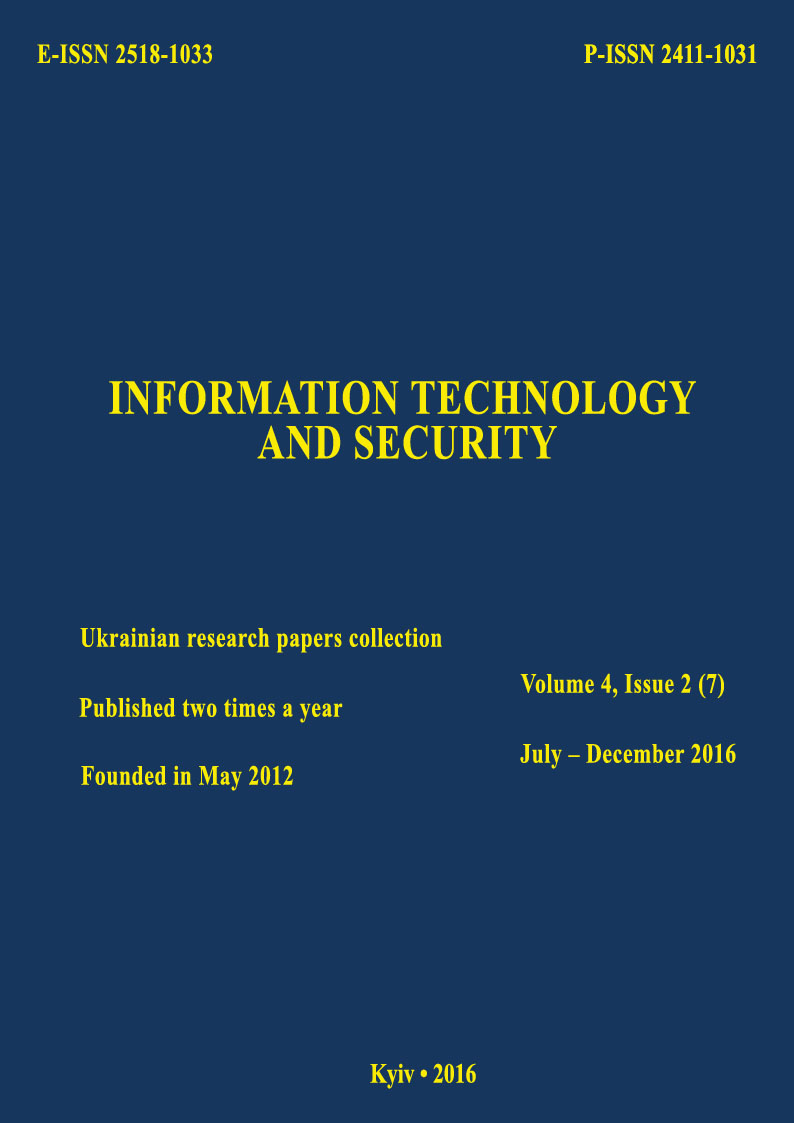Сonstruction of multilevel multiagent information systems based on knowledge
DOI:
https://doi.org/10.20535/2411-1031.2016.4.2.109910Keywords:
Domain-driven design, multi-level information system, set-theoretic approach, ontology, multi-agent system.Abstract
This article discusses the designing of multi-level information systems based on a subject domain model in the form of ontology. The principles of construction of multilevel systems are formulated; description structure and management levels of such systems are defined. Formal model of multilevel system is proposed. Proposed model is based on set-theoretic approach and takes into account aspects of multilevel system functioning: hierarchical, administrative, functional, and communicational. The peculiarities of creation and use of such systems are analyzed. Semantics of each level of the multilevel system based on ontological description is itemized. An approach to building of multilevel agents-based information systems using ontology of subject domains of their application is proposed. The universality of model description of agents within of the proposed approach is shown. The main roles of the agents as parts of multilevel systems and aspects of using and enriching by them of knowledge about the subject area of application are defined. The proposed approach to the designing of multilevel agent-based systems ensures the harmonization of semantics, functionality and architectural design implementations, and allows to realize pass-through process design with a combination of different notation for modeling systems. This model represents different levels of abstraction when considering information systems, while maintaining a meaningful relationship between these levels, ensuring correct transition from one level to another abstract representation, without losing the semantic unity at all levels.
References
International Organization for Standardization. (1996, June 15). ISO/IEC 7498-1. Information technology. Open Systems Interconnection. Basic Reference Model: The Basic Model. [Online]. Available: https://www.iso.org/standard/20269.html. Accessed on: Sept., 8, 2016.
O. E. Kovalenko, “The Architecture of Modular Distance Learning Systems”, Actual Proplems of Economics, no. 12 (78), pp. 172-176, 2007.
M.J. Wooldridge, An Introduction to Multiagent Systems. Chichester, United Kingdom: John Wiley and Sons, Ltd., 2002.
Y. Shoham, and K. Leyton-Brown, Multiagent systems: Algorithmic, game-theoretic, and logical foundations. Cambridge, United Kingdom: Cambridge University Press, 2008.
M. Niazi, and A.Hussain, “Agent-based computing from multi-agent systems to agent-based models: a visual survey”, Scientometrics, vol. 89, iss. 2, pp. 479-499, 2011.
doi: 10.1007/s11192-011-0468-9.
G.P. Chekinov, and S.G. Chekinov, “Application of the technology of multi-agent systems for intelligent decision support”, Systemotekhnika, no. 1, 2003. [Online]. Available: http://systech.miem.edu.ru/2003/n1/Chekinov.htm. Accessed on: Sept. 15, 2016.
I.L. Artemyeva, “Multilevel mathematical models of subject domains”, Artificial Intelligence, no. 4, pp. 85-94, 2006.
O.E. Kovalenko, “Semantically-functional approach to construction of multi-level e-learning systems”, in Proc. 4th Scientific-practical Conf. Decision Support Systems. Theory and Practice, Kyiv, 2008, pp. 166-169.
FIPA Agent Communication Language Specifications. [Online]. Available: http://www.fipa.org/repository/aclspecs.php3. Accessed on: Sept., 8, 2016.
[FIPA Communicative Act Library Specification. Available: http://www.fipa.org/specs/ fipa00037/SC00037J.pdf. Accessed on: Sept., 8, 2016.
FIPA P2P NA WG6. Functional Architecture Specification Draft 0.12. Available: http://www.fipa.org/subgroups/P2PNA-WG-docs/P2PNA-Spec-Draft0.12.doc. Accessed on: Sept., 8, 2016.
Downloads
Published
How to Cite
Issue
Section
License
Copyright (c) 2020 Collection "Information technology and security"

This work is licensed under a Creative Commons Attribution 4.0 International License.
The authors that are published in this collection, agree to the following terms:
- The authors reserve the right to authorship of their work and pass the collection right of first publication this work is licensed under the Creative Commons Attribution License, which allows others to freely distribute the published work with the obligatory reference to the authors of the original work and the first publication of the work in this collection.
- The authors have the right to conclude an agreement on exclusive distribution of the work in the form in which it was published this anthology (for example, to place the work in a digital repository institution or to publish in the structure of the monograph), provided that references to the first publication of the work in this collection.
- Policy of the journal allows and encourages the placement of authors on the Internet (for example, in storage facilities or on personal web sites) the manuscript of the work, prior to the submission of the manuscript to the editor, and during its editorial processing, as it contributes to productive scientific discussion and positive effect on the efficiency and dynamics of citations of published work (see The Effect of Open Access).

